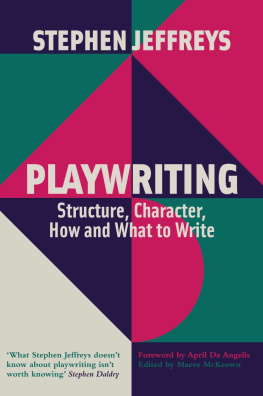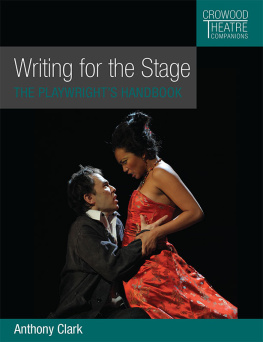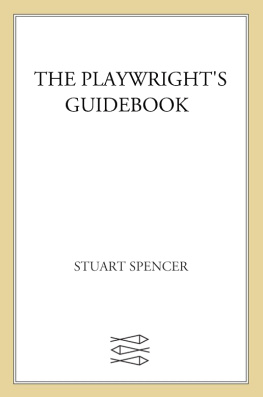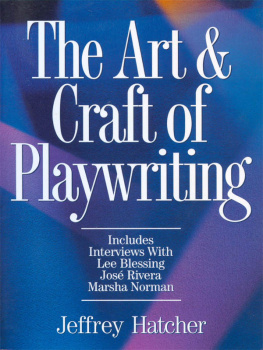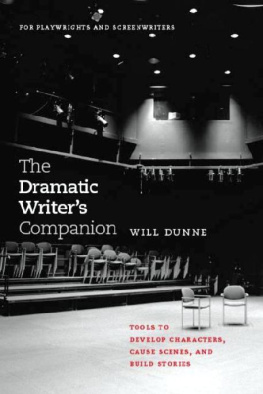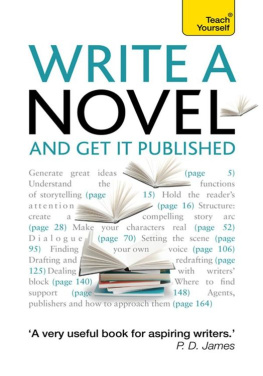STEPHEN JEFFREYS
PLAYWRITING
Structure, Character,
How and What to Write
Edited by Maeve McKeown
Foreword by April De Angelis
Afterwords by Simon Stephens,
Abi Morgan and Roy Williams

NICK HERN BOOKS
London
www.nickhernbooks.co.uk
Contents Foreword
I first met Stephen in a bar at the Riverside Studios, Hammersmith, in 1988 at a playwriting festival where an early play of mine was being read. I approached a tall man with a head of hair who looked friendly to ask if he had change for the cigarette machine. He did. We got into conversation. It was Stephen Jeffreys. I had struck gold.
As Writer-in-Residence at the theatre company, Paines Plough, Stephen had instituted a regular meeting of writers called The Wild Bunch, which met to discuss the craft: writers took turns to lead sessions on subjects such as exposition, three-act structure, dialogue, scene structure or even What makes you tick? He invited me to join. It was the first time I had come face to face with the writers craft, and it was all news to me.
Stephen was more than just a great bloke whose easy laugh set a room alight; he was a genuine geek, an obsessive about the craft of writing. His mantra could be guessed at Fit the content to the form with the emphasis on the latter. Every second on stage had to be interesting, and the only way to do that was to understand the medium you were working in, which was theatre not the novel. The novelist can dive inside the minds of characters, and give the reader every corner of their protagonists brain a playwright cant do that. How to get the inside outside was part of the quest, part of the immense jigsaw puzzle of technique that needed to be assembled to write a great play with the caveat that craft must support the imaginative vision of the writer. I became Stephens successor as Paines Ploughs Writer-in-Residence, and had the luck to travel the country with him, watching him give writing workshops. I took furious notes.
One time he asked a participant to sit facing the rest of us. He called him Character A. Hes very hungry, said Stephen. The dramatists job is not to let the character tell us that fact but to show us. How do we do that? The group pondered. They decided that another character, B, should come and sit next to the first and begin eating a packet of crisps. What does Character A do? Snatch the crisps? Befriend B? It was the beginning of a scene full of subtext, wants, conflict. It was a perfect method of teaching the number-one theatre rule of all time: to show, not tell. Stephen just came up with stuff like that on the spot. Awesome.
Stephen always stressed that the word playwright was spelled that way because plays were crafted for three-dimensional space, not merely written they were made like a wheelwright would make a wheel or a shipwright a ship. We were craftspeople: that was Stephens great insight and passion, which he pursued with generosity and brilliance his whole life, and which he conveyed to countless, grateful aspiring playwrights who wanted to wright their plays but to whom the mysteries of structure seemed opaque. Stephen had an admirable clarity of vision and a genius ability to teach through exercises and insights that was pretty breathtaking. His closed space/open space/closed time/open time matrix is now legendary as a tool for examining the relationship between form and content. His knowledge of plays was encyclopaedic. Listening to him, one realised that an intimate knowledge of existing plays was an invaluable resource for a writer.
So here in this book, thankfully, Stephen has downloaded his brain. As I read it I was reminded again of his deep connection to plays and how they work. There are gems in here, there is guidance, there is the spirit of Stephen Jeffreys always full of wonder at the amazing, complex, flexible invention the play is. The craft he illuminated in this gift of a book is there, just waiting for us to connect to it with our imagination, vision and passion in order to write the next good play, which is the lifeblood of the institution we are all devotees of: the theatre.
April De Angelis
Editors Note
S tephen and I started working on this book in 2012. I had been working with Stephen for three years by this point, as the administrator of his Playwriting Masterclass. I first met Stephen when I was an administrator at Out of Joint theatre company, who were producing his play The Convicts Opera (2008). As a young, aspiring playwright, I cheekily asked Stephen if I could attend his Masterclass and offer some admin support in exchange. Ever the affable and supportive mentor, Stephen allowed me to assist his then administrator, who subsequently handed the baton over to me, and I managed the next two Masterclasses myself.
I knew that Stephen was keen to write up his Masterclass but never had the time to do it. I recorded the Masterclass of June 2011 with a view to this. So, during a break from my PhD in 2012, I suggested to Stephen that I transcribe the audio recordings and write the first draft of the book. Stephen unhesitatingly agreed.
We spent a couple of weeks sitting at Stephens kitchen table. We worked on some sections of the book, reading the material for the first draft out loud. I asked him to expand on various points, and critiqued aspects of his ideas; I think Stephen liked that I pushed him. Stephen had big plans for the book. He wanted to add sections on using props and writing community plays, and to write a new chapter on Getting Produced. But things didnt transpire as planned. Despite my repeated attempts over the next few years to encourage Stephen to finish the book, his schedule was overflowing and mine was too, so we could never find time to continue.
Eventually in November 2017, Stephen emailed that he wanted to resume work on the book. We met up, and he had a renewed sense of urgency about it. I was keen to finish the book too, but I was trying to write my own book on political theory. We both determined to set aside what time we could.
Then, in January 2018, the terrible news came. Stephen had an inoperable brain tumour. I think he knew something was wrong, which was why he had contacted me about finishing the book in November. It was truly important to him to see his teaching live on for future generations of playwrights. Whatever held him back before no longer seemed to matter. I travelled down to London and worked with Stephen and his wife, the theatre and opera director Annabel Arden. But by the third meeting in March, Stephen was no longer able to speak in full sentences and Annabel had to translate between him and me. It became clear that Stephen was unable to continue the work and that it was over to me.
From day one of this project, way back in 2012, we had discussed referencing more plays by women and people of colour, and from different cultures. This was something Stephen was as passionate about as I am. As a mentor of many female playwrights, and having taught in Cuba, Hong Kong, Palestine, and Uganda, Stephen was onside. Frustratingly, in the 2011 Masterclass, he mostly referred to plays by British white men from the 1970s to 1990s. I had pointed this out to him, and he was keen to correct it, but he never got round to it. I have tried to ameliorate this to some extent by spending time in Stephens library a treasure trove of plays by women, plays from Africa, Asia, and all sorts of obscure old plays and adding details about them where appropriate. I used the plays Stephen owned, as well as the databases (see below).
Another aspect of the book that Stephen meant to spend time on was the sequence on The Nine Stories (). Again, with his immense knowledge of theatre, Im sure he would have added many more examples of stories for each myth. I have fleshed out what I can, drawing on his notes and comments, and the databases he had drawn up, as well as on input from others mentioned below. It should also be noted that, because this book is based on transcripts of lectures, I had to fact-check it retrospectively.
Next page
